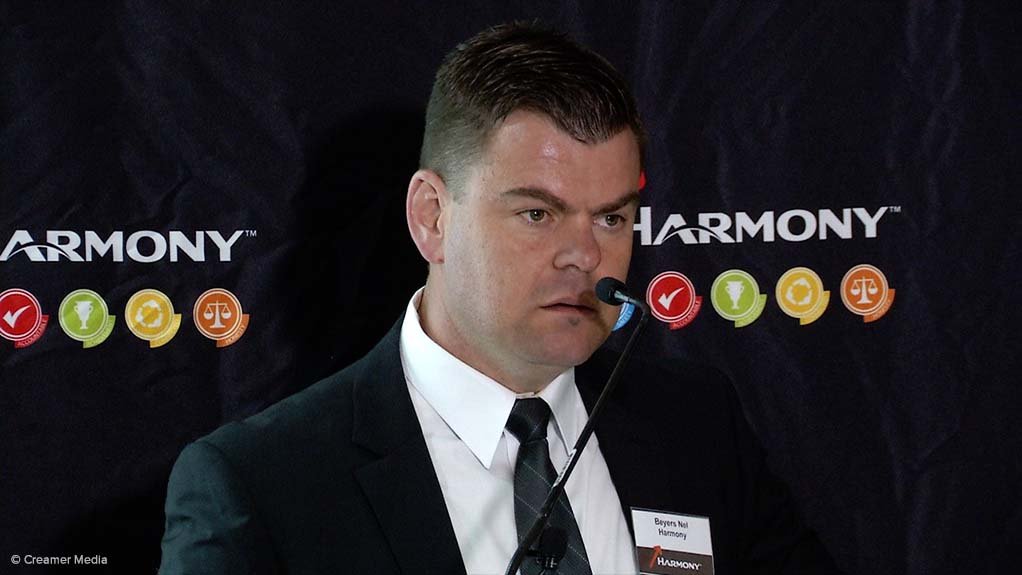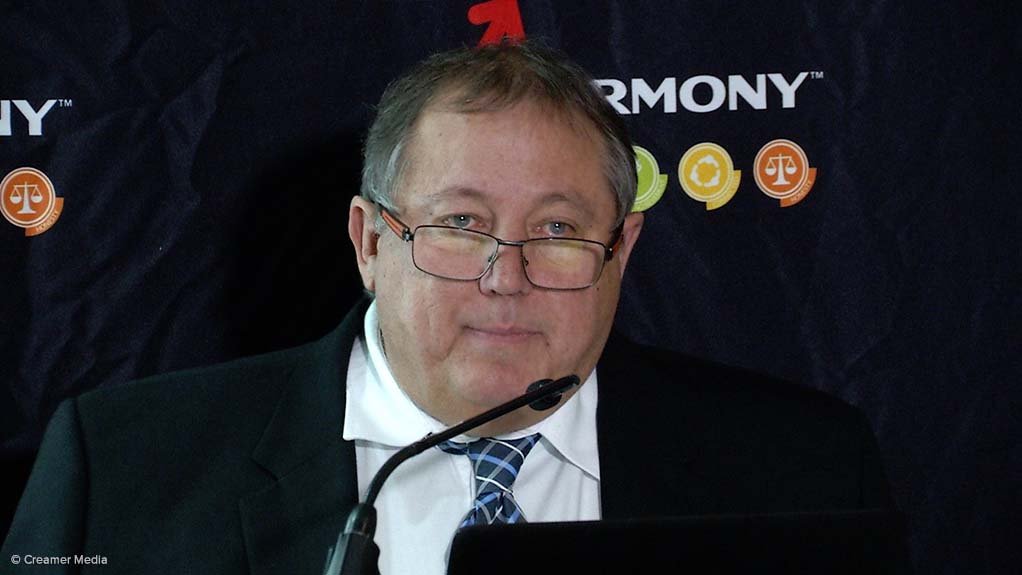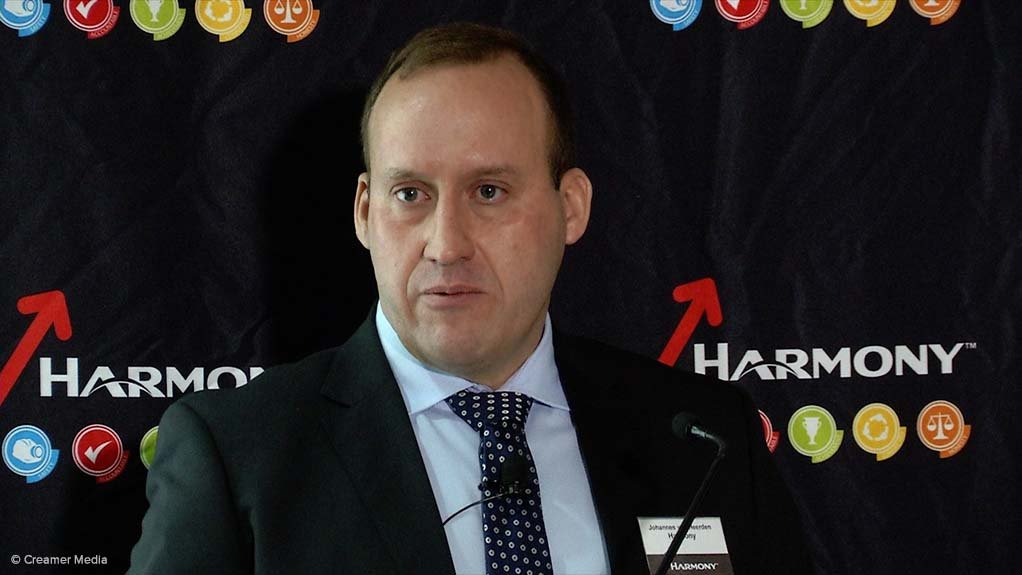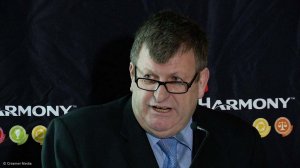JOHANNESBURG (miningweekly.com) – Gold mining company Harmony Gold, which spent R2.3-billion capital expenditure (capex) on its South African operations in the 12 months to June 30, will be increasing its capex to R2.7-billion for mainly the ongoing development of the Phakisa and Tshepong gold mines in the Free State.
The company, which recorded a net profit of R362-million, has just concluded a new dollar funding facility of $350-million, on which only $140-million has been drawn down to date, plus a R300-million drawdown on its R1-billion funding facility, which places it in a good position to fund growth opportunities. (Also watch attached Creamer Media video).
It is on track to produce at a rate of 1.5-million ounces in its next financial year and has among the lowest net debt positions in the gold mining industry.
The shares of the Johannesburg- and New York-listed Harmony rose on the JSE by 2.14% to R23.36 a share after the company announced a 70% year-on-year dividend increase to 85c a share for the year.
Key features in the 12 months to June 30 included a milestone fatality-free June quarter, the meeting of production guidance for a second year running, an increase in underground gold grade for a fifth consecutive year to 5.07 g/t, a 35% increase in headline earnings a share, the securing of cash margins through successful hedging, the cutting of net debt to R887-million and reaching a solution on upcoming silicosis claims.
Management is continuing to top up the hedging programmes, which realised gains of R1 747-million in the 12 months to June 30.
Harmony Gold South Africa head Beyers Nel told Mining Weekly Online that the Phakisa and Tshepong operations at which the bulk of the capex will be directed are being combined into a single operation.
Tshepong has under-utilised infrastructure and the newer Phakisa fully utilised infrastructure, which constrains production.
“So, what we’re doing is exploiting the synergies between the two to reach the point of one-plus-one being greater than two,” Nel said.
The combination of the two mines is demanding capital to create the face length and to produce more gold.
“A lot of next year’s capex is going to go to those two mines,” he told Mining Weekly Online.
Both are long-life, quality assets towards which R700-million capex is being prioritised.
Harmony CEO Peter Steenkamp added to Mining Weekly Online that the combination of the two mines would result in far more reef being directed towards Tshepong’s decline conveyor system, which will be extended deeper into high-grade areas and require costly additional refrigeration.
Harmony, which has nine underground mines, one opencast mine and many surface operations in South Africa, also owns significant gold-copper deposits in Papua New Guinea (PNG). Attributable gold equivalent mineral resources as declared at June 30, 2017, were 104.3-million ounces, a 0.9% decrease year-on-year.
The total gold contained in the mineral resources at the South African operations represents 53.2% of the company's total, with the PNG operations representing 46.8% of Harmony's total gold and gold equivalent mineral resources.
Attributable gold and gold equivalent mineral reserves amounted to 36.7-million ounces of gold, only a 0.5% decrease year-on-year.
TSHEPONG/PHAKISA INTEGRATION
The close proximity of the Tshepong and Phakisa mines provides an opportunity to optimise existing infrastructure of each operation. In the short-term, additional volumes from Phakisa will be hoisted from Tshepong.
On the gold-mining situation in South Africa, Steenkamp expressed belief in consolidation.
“I do believe Harmony’s got the model to operate well in South Africa. We’ve been very successful here over many years. We have very appropriate cost structures and strong beliefs on the quality of mining that should be put in place,” he said.
This is his second stint with Harmony and he spoke of being pleasantly surprised on his return at the quality underground work carried out by the company.
Harmony’s corporate and investor relations executive Marian van der Walt pointed out that the South African government had made a large financial contribution to research and development (R&D) aimed specifically at extending the life of the South African mining industry.
She said that Harmony had also made a large contribution to the R&D project, in which it was very actively involved and several universities had been tasked with finding ways of advancing mining.
Although many of South Africa’s current mines did not lend themselves to mechanisation, Steenkamp said that new generation shafts would take people further from the vulnerable areas of mines.
He was optimistic that ways could be found to make mining much safer and eliminate risks, particularly with the removal of rock after blasting.
In today’s robotic environment, he said it was probable that the typical current scraper-winch arrangements used to "clean" after blasting could be bettered.
“We’ll fully support that,” he said, adding that the company mining in PNG, where block-cave mining methods were not only safe but also very effective, has given it insight.
“Certainly, over years we’ll migrate to those types of orebodies wherever they are in the world and adopt those sorts of mining methods.
“In South Africa, the Wits basin is largely mined out. There are a few opportunities like at our Target North area. There are certainly huge opportunities there,” he outlined.
WAFI-GOLPU PROJECT
The Wafi-Golpu joint venture (JV) parties continued to progress activity in line with the forward work plan previously communicated, including engagement with the PNG government on a special mining lease for the Wafi-Golpu project.
The current study work is focussed on assessing self-generation power supply options at a level of some 100 MW, as well as reassessment of block cave levels and increased mining rates on increased knowledge obtained from further drilling undertaken during the year.
Also under consideration in PNG is deep sea tailings placement.
The JV parties are targeting a complete update of the feasibility study by the end of March. The focus of this work is to further optimise the business case and confirm any amendments necessary to the supporting documents for the special lease application.
Timing of first production is dependent on the updated study outcomes and the granting of the special lease.
Steenkamp spoke highly of the PNG mining policy model, which involves signing a mining lease with the government, which has a track record of honouring long-term agreements.
“PNG has a very good system operating there, which makes the country a very friendly place to go and invest,” he said.
EXPLORATION
Harmony’s exploration strategy is to target highly prospective underexplored terrains, pursue brownfield exploration targets close to existing infrastructure and thereby create value for shareholders by discovering large long-life bulk mineable gold and copper-gold deposits, and enhance the profitability of its existing operations.
Key work streams underpinning the exploration programme include brownfield exploration at the opencast Kalgold mine in South Africa for high-grade satellite resources, and at Hidden Valley in PNG to leverage existing opencast operations and extend mine life. Brownfield exploration is also taking place at underground operations in South Africa.
Harmony has been a key player in transforming the gold mining industry and remains committed to transformation in South Africa. Regulatory certainty is key to the future success and sustainability of the South African mining industry. It is important that the mining regulators take the interests of all stakeholders into account, says Steenkamp.
PRODUCTION AND COST GUIDANCE
In the next year, Harmony expects to produce 1.1-million ounces at an all-in sustaining cost of $1 180/oz, or R520 000/kg, at an exchange rate of R13.74 to the dollar. It will not mine areas that are unsafe or at grades lower than planned.
EMAIL THIS ARTICLE SAVE THIS ARTICLE ARTICLE ENQUIRY
To subscribe email subscriptions@creamermedia.co.za or click here
To advertise email advertising@creamermedia.co.za or click here
















